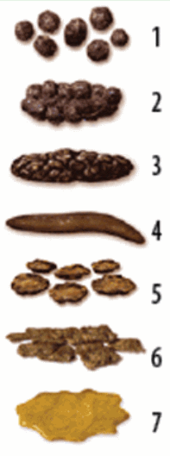Bristol chair shape scale
The Bristol Stool Scale (English Bristol Stool Scale , including Bristol Stool Chart ) is a table overview of shape and texture human chair . It was developed by Kenneth Heaton and SJ Lewis from the University of Bristol and suggested as a diagnostic tool to assess the length of intestinal transit , which in turn can indicate a number of diseases (for example irritable bowel syndrome ). It was published in the Scandinavian Journal of Gastroenterology in 1997 .
According to the Bristol chair shape scale, seven types of stool are distinguished, with the passage time decreasing from type 1 (up to 100 hours) to type 7 (about 10 hours):
- Type 1: Individual, firm globules, difficult to excrete
- Type 2: Sausage-like, lumpy
- Type 3: Sausage-like with a cracked surface
- Type 4: Sausage-like with a smooth surface
- Type 5: Individual, soft, smooth-edged lumps, easy to excrete
- Type 6: Individual, soft lumps with an irregular edge
- Type 7: Liquid, without solid components
Types 1 and 2 indicate constipation , types 5 to 7 indicate diarrhea . Types 3 and 4 are considered to be the “ideal chair” that is easy to pass out and does not indicate any illnesses.
Individual evidence
- ^ Lewis SJ, Heaton KW: Stool form scale as a useful guide to intestinal transit time . In: Scand. J. Gastroenterol. . 32, No. 9, 1997, pp. 920-4. PMID 9299672 .
